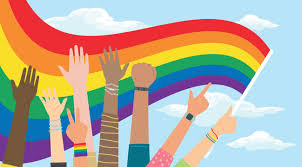It is LGBTQ+ Pride Month! We all know that pride month celebrates all of the amazing people who are LGBTQ+, and recognizes the positive impact that lesbian, gay, bisexual, transgender and other individuals have had on history. Heritage of Pride is the nonprofit organization that established the original Pride events and still plans and produces them every year. They also create the theme of the event. This year’s theme is “Reflect. Empower. Unite.” The theme can be explained as ‘inspiring us to reflect on the progress we who are LGBTQ+ have made, teaches us to empower ourselves and our community, and unites us all in our commitment to inclusion.’
Those who are LGBTQ+ are actually more likely to be diagnosed with Borderline Personality Disorder (BPD) than heterosexual counterparts, so that there is a high diagnosis bias. The diagnosis bias is the implicit assumption that LGBTQ+ individuals are more prone to and more likely to have mental disorders than others. I wonder if the psychiatrist who diagnosed me with BPD was biased because I am bisexual.
The theme this Pride Month of “Reflect. Empower. Unite.” can be very useful for those of us with BPD as well. To ‘reflect’ means to examine one’s own conscious thoughts and feelings as a way to gain insight and a better understanding of ourselves and how we think, feel, and behave. Self-reflection can be used to grow our self-awareness, which is important to do when having BPD. Self-reflection also helps to improve decision-making, enhance emotional intelligence, and can lead to better relationships and personal growth. Journaling is one of the most effective ways to practice self-reflection. Another great way to self-reflect is through creative emotional expressions, like painting or drawing, writing, or making music. I myself use art as a way to reflect. I always have ten or fifteen pieces I am working on at any given time!
To ‘empower’ means to give someone the confidence or strength to do something, like encouraging, motivating, and inspiring them. One of the best ways to empower yourself is by advocating for yourself. (Extra points when advocating for others as well!) Self-advocacy is the ability to speak up for ourselves and have our needs met. It is to clearly articulate needs and boundaries to others, and, if something does not feel right, speak up and ask questions. This can be extremely useful during mental health appointments. Remember, mental health professionals are there for us, and decisions must be made with us, not for us. Another method of self-empowerment is goal setting. Set S.M.A.R.T. (Specific, Measurable, Achievable, Relevant, and Time-bound) goals for yourself, and then crush those goals. I love challenges, so one of my goals is to challenge myself to do something new, something I have not done before. It helps to get me out of my comfort zone. Getting out of our comfort zones helps us to develop new skills and adapt to new situations, which can lead to a deeper understanding of self.
To ‘unite’ means to join together as a group for a common purpose or action, like if we who are LGBTQ+ and have BPD joined together for the purpose of helping to end stigma. The steps to uniting people are establishing a shared vision (ending stigma), building trust (by helping others), and leading by example (leading an anti-stigma or educational campaign), uniting as a group to celebrate each others uniqueness and shared vision to end the stigma of mental health. I truly believe that by doing this, we can change the world.
Those of us with BPD and LGBTQ+ identities are in a novel position. While some of us go through a process of questioning our identity as someone who is LGBTQ+, we also may have one of the core symptoms of BPD, which is to have an unstable self-image or sense of self. I personally have suffered with an unstable sense of self at times in my life, but I have always had a passion for making art. Art has saved my life more than a few times. BPD-diagnosed LGBTQ+ individuals face even more societal prejudice and stigma than those who are just LGBTQ+ or just have BPD. That makes it even more important that we stand united together for Pride month, and for every other day of the year. We CAN end the stigmas we face.
I think that we have a unique superpower. We have the pride of being LGBTQ+ and the pride that comes with our healing journey and overcoming our BPD. Though the phrase BPD Pride is contradictory, as it could mean pride-in-having-BPD or pride-despite-having-BPD, I think it is up to each one of us to determine what BPD Pride is to us. I believe it is not pride that we have BPD, but pride in overcoming our symptoms of BPD. We all have our own distinctive BPD healing journeys, and sharing our stories can inspire others in their own journeys. Never be afraid to tell your story. It can be an inspiration to others and it can change lives.
About the Author: Amber Joy Kostecki is an artist, an altruist, and founder of three mental health nonprofits. She serves on the NEABPD Lived Experience Committee because it is her life’s purpose to help others.


0 Comments